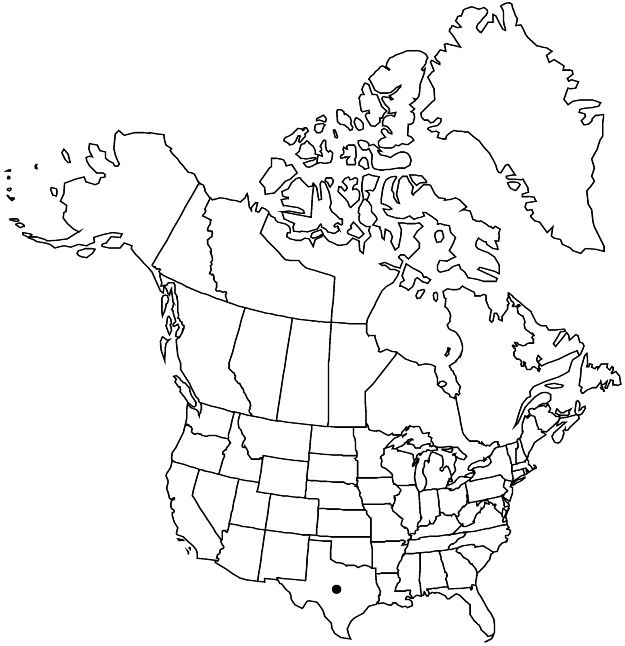Difference between revisions of "Passiflora filipes"
Pl. Hartw., 118. 1843.
FNA>Volume Importer |
imported>Volume Importer |
||
| (6 intermediate revisions by 2 users not shown) | |||
| Line 23: | Line 23: | ||
|elevation=10 m | |elevation=10 m | ||
|distribution=Tex.;Mexico;Central America;South America (Ecuador;Venezuela). | |distribution=Tex.;Mexico;Central America;South America (Ecuador;Venezuela). | ||
| − | |discussion=<p>Passiflora filipes and P. lutea are morphologically similar and closely related (E. P. Killip 1938), yet they do not occur sympatrically. In the flora area, P. filipes is restricted to southernmost Texas; the southern range limit of P. lutea is at least 150 km north of the range of P. filipes. In addition to the relative lengths of middle leaf lobes, seed surface features distinguish these two species, with sharply and coarsely foveate seeds in P. filipes versus the more delicately and transversely sulcate seeds of P. lutea.</p> | + | |discussion=<p><i>Passiflora filipes</i> and <i>P. lutea</i> are morphologically similar and closely related (E. P. Killip 1938), yet they do not occur sympatrically. In the flora area, <i>P. filipes</i> is restricted to southernmost Texas; the southern range limit of <i>P. lutea</i> is at least 150 km north of the range of <i>P. filipes</i>. In addition to the relative lengths of middle leaf lobes, seed surface features distinguish these two species, with sharply and coarsely foveate seeds in <i>P. filipes</i> versus the more delicately and transversely sulcate seeds of <i>P. lutea</i>.</p> |
|tables= | |tables= | ||
|references= | |references= | ||
| Line 32: | Line 32: | ||
-->{{#Taxon: | -->{{#Taxon: | ||
name=Passiflora filipes | name=Passiflora filipes | ||
| − | |||
|authority=Bentham | |authority=Bentham | ||
|rank=species | |rank=species | ||
| Line 47: | Line 46: | ||
|publication year=1843 | |publication year=1843 | ||
|special status= | |special status= | ||
| − | |source xml=https:// | + | |source xml=https://bitbucket.org/aafc-mbb/fna-data-curation/src/2e0870ddd59836b60bcf96646a41e87ea5a5943a/coarse_grained_fna_xml/V6/V6_327.xml |
|genus=Passiflora | |genus=Passiflora | ||
|species=Passiflora filipes | |species=Passiflora filipes | ||
Latest revision as of 22:20, 5 November 2020
Stems terete, glabrous. Leaves not pungent, glabrous; stipules linear-lanceolate, falcate, 2–4 × 0.5–1 mm, eglandular; petiole eglandular; blade roughly symmetric, 1–3(–5) × 1.5–6(–8) cm, shallowly 3-lobed, middle lobe ± as long as lateral lobes (usually to 1/4 blade length), margins entire; abaxial fine veins not raised (especially in dried specimens), abaxial nectaries absent. Floral bracts absent. Flowers: floral tube absent; sepals pale green, 7–10 × 2–3 mm; petals pale green, 3–5 × 1 mm; corona filament whorls 2, outer filaments white basally, pale yellow apically, filiform, terete, 6–7 mm. Berries purple-black, globose, 5–10 × 5–10 mm.
Phenology: Flowering Oct–Feb.
Habitat: Subtropical woodlands, in moist, loamy soil
Elevation: 10 m
Distribution

Tex., Mexico, Central America, South America (Ecuador, Venezuela).
Discussion
Passiflora filipes and P. lutea are morphologically similar and closely related (E. P. Killip 1938), yet they do not occur sympatrically. In the flora area, P. filipes is restricted to southernmost Texas; the southern range limit of P. lutea is at least 150 km north of the range of P. filipes. In addition to the relative lengths of middle leaf lobes, seed surface features distinguish these two species, with sharply and coarsely foveate seeds in P. filipes versus the more delicately and transversely sulcate seeds of P. lutea.
Selected References
None.